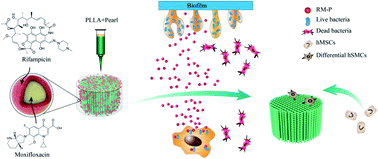3D-printed composite scaffold with anti-infection and osteogenesis potential against infected bone defects
Abstract
In the field of orthopedics, an infected bone defect is a refractory disease accompanied by bone infection and defects as well as aggravated circulation. There are currently no personalized scaffolds that can treat bone infections using local stable and sustained-release antibiotics while providing mechanical support and bone induction to promote bone repair in the process of absorption in vivo. In our previous study, rifampicin/moxifloxacin-poly lactic-co-glycolic acid (PLGA) microspheres were prepared and tested for sustained release and antibacterial activity. The composite scaffold of poly-L-lactic acid (PLLA)/Pearl had a positive effect on mechanics supports and promoted osteogenesis. Therefore, in this study, the personalized scaffolds of PLLA/Pearl were first prepared by 3D printing. Then, rifampicin/moxifloxacin-PLGA (RM-P) microspheres were loaded into the scaffold pores to prepare the PLLA/Pearl/RM-P scaffolds. In this in vitro study, we investigated the structural characteristics and cytocompatibility of 3D-printed composite scaffolds, which indicates the integrity of the components in the scaffolds. The PLLA/Pearl and PLLA/Pearl/RM-P composite scaffolds can promote adhesion, proliferation, and differentiation of human bone marrow mesenchymal stem cells. Moreover, a rabbit model of infected bone defects of the radius was established. PLLA, PLLA/Pearl, and PLLA/Pearl/RM-P scaffolds were implanted into the bone nidus. The therapeutic effect of the three scaffolds on the infected bone defects was evaluated through imaging and microbiological and histological analysis after surgery. Among the three scaffolds, only the PLLA/Pearl/RM-P scaffold had anti-infection and bone defect repair in vivo. 3D printing provides support for personalized scaffold structures, and composite materials ensure that the scaffolds exert anti-infection and bone repair effects. Our study suggests that the PLLA/Pearl/RM-P scaffold is a promising new material in the clinical treatment of infected bone defects.



 Please wait while we load your content...
Please wait while we load your content...